The primary qualification for joining a legion was Roman citizenship,
although this does not mean that all legionaries came from Italy. On the
contrary, citizenship throughout the empire was widely awarded for meritorious
service, especially in the army’s auxiliary regiments. Selection
procedures were rigorous and the training tough. Legionaries were well
paid, and on satisfactory completion of service - usually 25 years - they
received a substantial lump sum which often allowed them to settle in
the civilian areas of the province and become citizens of substance.
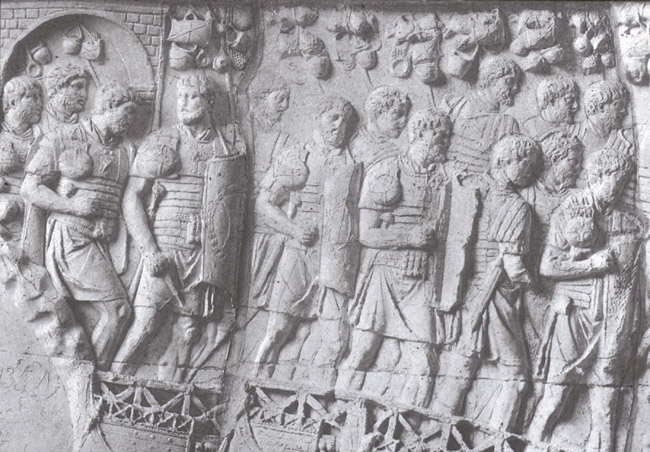
Legionaries on Trajan's Column march
out on campaign. They wear segmented body-armour and carry long cylindrical
shields and short swords. Helmets are slung on their right shoulders,
while over their left they carry stakes on which their kit is hung.
Their javelins or pilae were represented in metal, which is
now gone.
© Author's collection
In the organisation, equipment, and tactics of its legions the Roman army had refined the simple technologies of the ancient world to devastating effect. Success was achieved by a combination of shock, disciplined order, and adaptability. In action the legionaries would first present a wall of shields. This protected them from enemy missiles. As they drew close to the enemy line each man discharged two javelins, or pilae, with soft iron shanks which bent on impact. If they found their target this made them hard to withdraw, while if they missed they were useless for throwing back. As battle was joined the shields became offensive weapons, used in concert to push against the enemy and knock him off balance. At the same time the legionaries brought their short stabbing swords to bear, thrusting out from between the shields to inflict deadly penetrative wounds. The tactics were akin to those of modern riot police, though vastly more lethal.
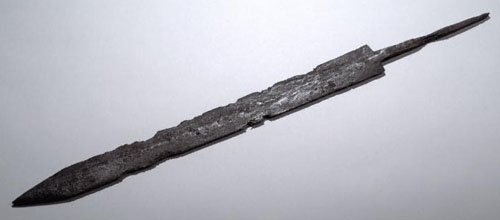
A legionary sword or gladius
from Newstead.
© SCRAN/National Museums of Scotland
This formidable weapons-system was greatly enhanced by the ability to
switch tactics in the midst of battle. A classical author, Josephus, explains
that ‘their drills are bloodless battles, their battles bloody drills.’
The design of legionaries’ helmets supports his statement: they
were cleverly adapted to give maximum protection without compromising
their wearer’s hearing, forward and peripheral vision, and ability
to communicate by voice. Unimpeded use of all the senses was evidently
vital on the Roman battlefield.

The author wearing a replica Roman legionary
helmet
© Paula Martin
Because a Roman legion was virtually impossible to defeat, it almost never had to fight. Its mere presence was usually enough, rather like the nuclear threat during the Cold War. Even when battle was joined the legions were normally held back, to be used only in the last resort. In describing Mons Graupius, when Agricola defeated the Caledonian host, Tacitus observes that the legions stood in reserve, noting that ‘victory would be vastly more glorious if it cost no Roman [i.e. citizen] blood’. On this occasion the bloody work was accomplished solely by non-citizen auxiliary troops.
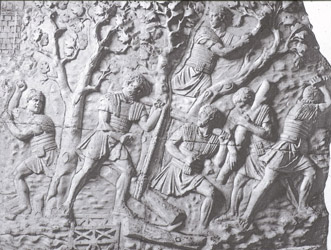
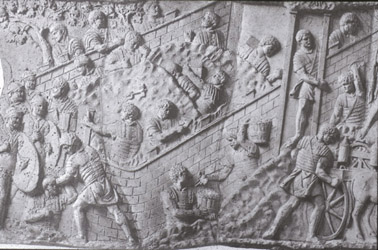
Legionaries on Trajan's Column
fell and transport timber.
© Author's collection
Legionaries build a fort: another
scene from Trajan's Column.
© Author's collection
Complementing a legion’s ability to fight was
another asset which the Roman mind prized even more strongly. This was
the ability to build. On Trajan’s Column, a monument intended above
all else to glorify the achievements of the Roman army, legionaries are
almost never seen in combat. Instead they are shown labouring
- cutting down trees; digging ditches; building forts, roads, bridges,
or boats; harvesting grain. It is always the humble auxiliaries who engage
in the rough-and-tumble heroics of battle. The perception of contemporary
Romans is clear - anyone can fight, but only Rome’s elite citizen
troops can build.
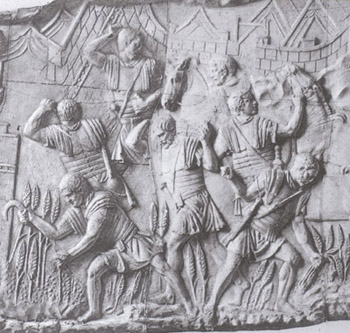
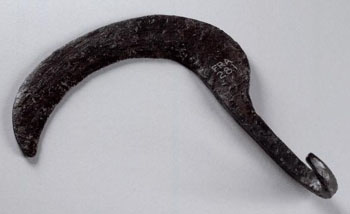
Left, legionaries harvest grain outside their camp,
a detail from Trajan's
Column.
© Author's collection
Above, a sickle from Newstead.
© SCRAN/National Museums of Scotland
To the Romans, building was more worthy and far more enduring than fighting.
The subjugation, occupation, and control of enemy territories was achieved
by setting up the networks of roads and garrisons which legionary soldier-craftsmen
alone could create. Along these roads and among these garrisons information
was passed, processed, and acted upon through the medium of literacy.
Writing, and the infrastructure through which it was transmitted, was
the Roman army’s ultimate secret weapon. Information technology
could be as powerful in the ancient world as it is today.